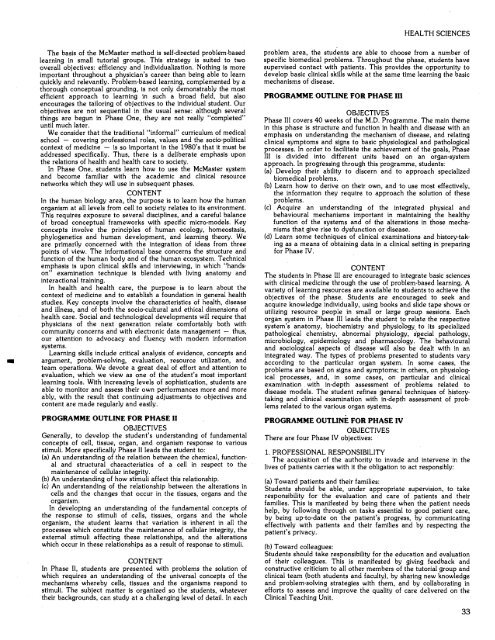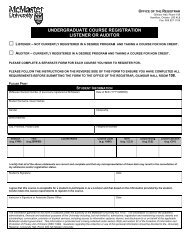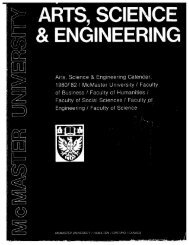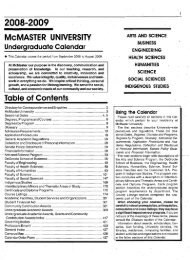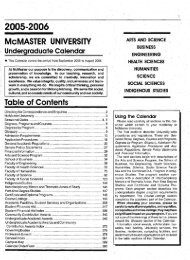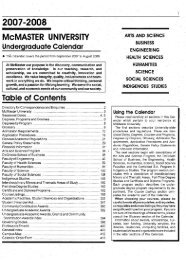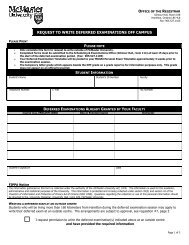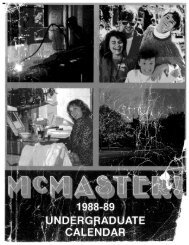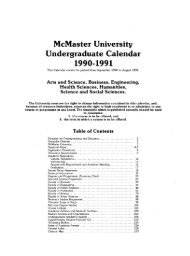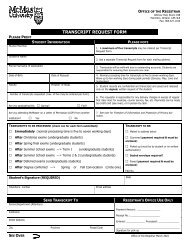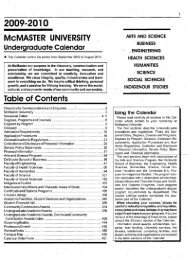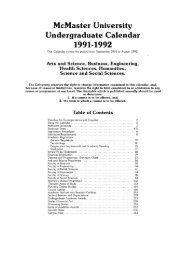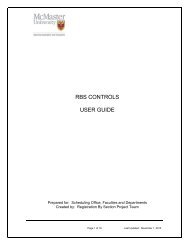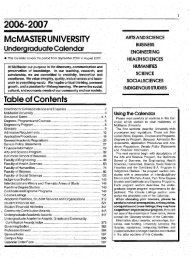-The basis <strong>of</strong> <strong>the</strong> <strong>McMaster</strong> method is self-directed problem-basedlearning in small tutorial groups. This strategy is suited to twooverall objectives: efficiency and individualization. Nothing is moreimportant throughout a physician's career than being able to learnqUickly and relevantly. Problem-based learning, complemented byathorough conceptual grounding, is not only demonstrably <strong>the</strong> mostefficient approach to learning in such a broad field, but alsoencourages <strong>the</strong> tailoring <strong>of</strong> objectives to <strong>the</strong> individual student. Ourobjectives are not sequential in <strong>the</strong> usual sense: although severalthings are begun in Phase One, <strong>the</strong>y are not really "completed"until much later.We consider that <strong>the</strong> traditional "informal" curriculum <strong>of</strong> medicalschool - covering pr<strong>of</strong>essional roles, values and <strong>the</strong> socio-politicalc;ontext <strong>of</strong> medicine - is so important in <strong>the</strong> 1980's that it must beaddressed specifically. Thus, <strong>the</strong>re is a deliberate emphasis upon<strong>the</strong> relations <strong>of</strong> health and health care to society.In Phase One, students learn how to use <strong>the</strong> <strong>McMaster</strong> systemand become familiar with <strong>the</strong> academic and clinical resourcenetworks which <strong>the</strong>y will use in subsequent phases.CONTENTIn <strong>the</strong> human biology area, <strong>the</strong> purpose is to learn how <strong>the</strong> humanorganism at all levels from cell to society relates to its environment.This requires exposure to several disciplines, and a careful balance<strong>of</strong> broad conceptual frameworks with specific micro·models. Keyconcepts involve <strong>the</strong> principles <strong>of</strong> human ecology, homeostasis,phylogenetics and human development, and learning <strong>the</strong>ory. Weare primarily concerned with <strong>the</strong> integration <strong>of</strong> ideas from threepoints <strong>of</strong> view. The informational base concerns <strong>the</strong> structure andfunction <strong>of</strong> <strong>the</strong> human body and <strong>of</strong> <strong>the</strong> human ecosystem. Technicalemphasis is upon clinical skills and interviewing, in which "handson"examination technique is blended with living anatomy andinteractional training.In health and health care, <strong>the</strong> purpose is to learn about <strong>the</strong>context <strong>of</strong> medicine and to establish a foundation in general healthstudies. Key concepts involve <strong>the</strong> characteristics <strong>of</strong> health, diseaseand illness, and' <strong>of</strong> both <strong>the</strong> socio-cultural and ethical dimensions <strong>of</strong>health care. Social and technological developments will require thatphysicians <strong>of</strong> <strong>the</strong> next generation relate comfortably both withcommunity concerns and with electronic data management - thus,our attention to advocacy and fluency with modern informationsystems.Learning skills include critical analysis <strong>of</strong> eVidence, concepts andargument, problem-solving, evaluation, resource utilization, andteam operations. We devote a great deal <strong>of</strong> effort and attention toevaluation, which we view as one <strong>of</strong> <strong>the</strong> student's most importantlearning tools. With increasing levels <strong>of</strong> sophistication, students areable to monitor and assess <strong>the</strong>ir own performances more and moreably, with <strong>the</strong> result that continuing adjustments to objectives andcontent are made regularly and easily.PROGR,AMME OUTLINE FOR PHASE IIOBJECTIVESGenerally, to develop <strong>the</strong> student's understanding <strong>of</strong> fundamentalconcepts <strong>of</strong> cell, tissue, organ, and organism response to variousstimuli. More specifically Phase II leads <strong>the</strong> student to:(a) An understanding <strong>of</strong> <strong>the</strong> relation between <strong>the</strong> chemical, functionaland structural characteristics <strong>of</strong> a cell in respect to <strong>the</strong>maintenance <strong>of</strong> cellular integrity.(b) An understanding <strong>of</strong> how stimuli affect this relationship.(c) An understanding <strong>of</strong> <strong>the</strong> relationship between <strong>the</strong> alterations incells and <strong>the</strong> changes that occur in <strong>the</strong> tissues, organs and <strong>the</strong>organism.In developing an understanding <strong>of</strong> <strong>the</strong> fundamental concepts <strong>of</strong><strong>the</strong> response to stimuli <strong>of</strong> cells, tissues, organs and <strong>the</strong> wholeorganism, <strong>the</strong> student learns that variation is inherent in all <strong>the</strong>processes which constitute <strong>the</strong> maintenance <strong>of</strong> cellular integrity, <strong>the</strong>external stimuli affecting <strong>the</strong>se relationships, and <strong>the</strong> alterationswhich occur in <strong>the</strong>se relationships as a result <strong>of</strong> response to stimuli.CONTENTIn Phase II, students Ilre presented with problems <strong>the</strong> solution <strong>of</strong>which requires an understanding <strong>of</strong> <strong>the</strong> universal concepts <strong>of</strong> <strong>the</strong>mechanisms whereby cells, tissues and <strong>the</strong> organisms respond tostimuli. The subject matter is organized so <strong>the</strong> students, whatever<strong>the</strong>ir backgrounds, can study at a challenging level <strong>of</strong> detail. In eachHEALTH SCIENCESproblem area, <strong>the</strong> stud~nts are able to choose from a number <strong>of</strong>specific biomedical problems. Throughout <strong>the</strong> phase, students havesupervised contact with patients. This provides <strong>the</strong> opportunity todevelop basic clinical skills while at <strong>the</strong> same time learning <strong>the</strong> basicmechanisms <strong>of</strong> disease.PROGRAMME OUTLINE FOR PHASE IIIOBJECTIVESPhase III covers 40 weeks <strong>of</strong> <strong>the</strong> M.D. Programme. The main <strong>the</strong>mein this phase is structure and function in health and disease with anemphasis on understanding <strong>the</strong> mechanism <strong>of</strong> disease, and relatingclinical symptoms and signs to basic physiological and pathologicalprocesses. In order to facilitate <strong>the</strong> achievement <strong>of</strong> <strong>the</strong> goals, PhaseIII is divided into different units based on an organ-systemapproach. In progt'essing through this programme, students:(a) Develop <strong>the</strong>ir ability to discern and to approach specializedbiomedical problems.(b) Learn how to derive on <strong>the</strong>ir own, and to use most effectively,<strong>the</strong> information <strong>the</strong>y require to approach <strong>the</strong> solution <strong>of</strong> <strong>the</strong>seproblems.(c) Acquire an understanding <strong>of</strong> <strong>the</strong> integrated physical andbehavioural mechanisms important in maintaining <strong>the</strong> healthyfunction <strong>of</strong> <strong>the</strong> systems and <strong>of</strong> <strong>the</strong> alterations in those mechanismsthat give rise to dysfunction or disease.(d) Learn some techniques <strong>of</strong> clinical examinations and history-takingas a means <strong>of</strong> obtaining data in a clinical setting in preparingfor Phase IV.CONTENTThe students in Phase III are encouraged to integrate basic scienceswith clinical medicine through <strong>the</strong> use <strong>of</strong> problem-based learning. Avariety <strong>of</strong> learning resources are available to students to achieve <strong>the</strong>objectives <strong>of</strong> <strong>the</strong> phase. Students are encouraged to seek andacquire knowledge indiVidually, using books and slide tape shows orutilizing resource people in small or latge group sessions. Eachorgan system in Phase III leads <strong>the</strong> student to relate <strong>the</strong> respectivesystem's anatomy, biochemistry and physiology, to its specializedpathological chemistry, abnormal physiology, special pathology,microbiology, epidemiology and pharmacology. -The behaviouraland sociological aspects <strong>of</strong> disease will also be dealt with in anintegrated way. The types <strong>of</strong> problems presented to students varyaccording to <strong>the</strong> particular organ system. In some cases, <strong>the</strong>problems are based on signs and symptoms; in o<strong>the</strong>rs, on physiologicalprocesses, and, in some cases, on particular and clinicalexamination . with in-depth assessment <strong>of</strong> problems related todisease models. The student refines general techniques <strong>of</strong> historytakingand clinical examination with in-depth assessment <strong>of</strong> problemsrelated to <strong>the</strong> various organ systems.PROGRAMME OUTLINE FOR PHASE IVOBJECTIVESThere are four Phase IV objectives:1. PROFESSIONAL RESPONSIBILITYThe acquisition <strong>of</strong> <strong>the</strong> authority to invade and intervene in <strong>the</strong>lives <strong>of</strong> patients carries with it <strong>the</strong> obligation to act responsibly:(a) Toward patients and <strong>the</strong>ir families:Students should be able, under appropriate supervIsion, to takeresponsibility for <strong>the</strong> evaluation and care <strong>of</strong> patients and <strong>the</strong>irfamilies. This is manifested by being <strong>the</strong>re when <strong>the</strong> patient needshelp, by following through on tasks essential to good patient care,by being up-to-date on <strong>the</strong> patient's progress, by communicatingeffectively with patients and <strong>the</strong>ir families and by respecting <strong>the</strong>patient's privacy.(b) Toward colleagues:Students should take responsibility for <strong>the</strong> education and evaluation<strong>of</strong> <strong>the</strong>ir colleagues. This is manifested by giving feedback andconstructive criticism to all o<strong>the</strong>r members <strong>of</strong> <strong>the</strong> tutorial group andclinical team (both students and faculty), by sharing new knowledgeand problem-solving strategies with <strong>the</strong>m, and by collaborating inefforts to assess and improve <strong>the</strong> quality <strong>of</strong> care delivered on <strong>the</strong>Clinical Teaching Unit.33
HEALTH SCIENCES(c) Toward <strong>the</strong> community:Students should take responsibility for <strong>the</strong> maintenance and improvement<strong>of</strong> health in <strong>the</strong> general population_ This is manifestedby making efforts to learn about issues (from etiological to healthcare organizational) that affect health in <strong>the</strong> community, byspeaking out in an informed fashion on issues that affect <strong>the</strong> publichealth, and by responding to <strong>the</strong> commuI'lity's requests for expertadvice and aid. .(d) Toward staff:Students should be able to recognize and acknowledge limitations in<strong>the</strong>ir own knowledge, skills and attitudes and to do something about<strong>the</strong>m. This is manifested:1. by recognizing knowledge gaps and carrying out self-directedlearning (see below);2. by recognizing one's own emotional reactions to illness and beingprepared to talk about <strong>the</strong>m and obtain support as needed;3. by recognizing that <strong>the</strong> congruity between <strong>the</strong> clinician's andpatient's value systems, attitudes and behaviours will pr<strong>of</strong>oundlyaffect <strong>the</strong> clinician's ability to help <strong>the</strong> patient.(Self-assessment is not an end in itself, but a means to self-improvementand keeping up-to-date; <strong>the</strong> objective here is a periodicself-monitoring system)2. CLINICAL SKILLS:Students should show some competency in <strong>the</strong> acquisition, collation,recording and interpretation <strong>of</strong> clinical data. The depth <strong>of</strong> strictlytechnical competency in <strong>the</strong> elicitation <strong>of</strong> clinical data that will berequired at <strong>the</strong> start <strong>of</strong> a clinical rotation and acquired during it willbe set by each <strong>of</strong> <strong>the</strong> clinical departments.O<strong>the</strong>r elements <strong>of</strong> clinical skills apply to all rotations, and <strong>the</strong>sewill be manifested by:(a) when obtaining or recording clinical data, <strong>the</strong> recognition andacknowledgement <strong>of</strong> variation and error in clinical measurement.(b) when ordering diagnostic tests, <strong>the</strong> ability to determine <strong>the</strong>iraccuracy, precision, utility and cost and <strong>the</strong>ir ranges in sicknessand in health.(c) when recording clinical data, <strong>the</strong> ability to set up and use someversion <strong>of</strong> <strong>the</strong> problem-oriented medical record.3. PROBLEM-SOLVINGWhen faced with patients, students should be able to execute all <strong>of</strong><strong>the</strong> following steps <strong>of</strong> biomedical problem-solving:•(a) determine why <strong>the</strong> patients are seeking help (problem-sensing).(b) generate hypo<strong>the</strong>ses to explain <strong>the</strong> patient's problem.(c) acquire relevant clinical data (from history, clinical exam,laboratory investigation) and relevant biomedical knowledgeranging from molecular to societal structure and function (fromvarious educational resources). In doing so, students shouldmanifest self-direction learning ability (correctly identifying areas<strong>of</strong> ignorance, efficiently tracking down educational resources,appropriately relating new knowledge back to <strong>the</strong> patient) andcompetency in <strong>the</strong> critical asse§"sment <strong>of</strong> evidence (correctlyidentifying <strong>the</strong> scientific merit <strong>of</strong> publications related to clincialcourse and prognosis, to etiology and causation and to claimsthat preventive <strong>the</strong>rapeutic or rehabilitative manoeuvres domore good than harm).(d) revise <strong>the</strong> list <strong>of</strong> hypo<strong>the</strong>ses in light <strong>of</strong> this additional knowledgeand prepare a problem list (including diagnostic labels andreasonable alternative explanations) and a statement <strong>of</strong> urgencyand functional disability involved in <strong>the</strong> case (syn<strong>the</strong>ses).(e) identify residual gaps in one's understanding <strong>of</strong> <strong>the</strong> patient, <strong>the</strong>illness, human biology and health care (evaluation).4. TEAMThe student should function effectively as a member <strong>of</strong> a clinicalteam. This is manifested by <strong>the</strong> ability to: cooperate with o<strong>the</strong>rs incaring for <strong>the</strong> individual patient; communicate with and be understoodby o<strong>the</strong>rs in <strong>the</strong> team; contribute "to team problem-solving sothat it is accomplished qUicker and better, give and receivefeedback on performance.CONTENTThe Phase IV Programme consists at present <strong>of</strong> three sixteen-weekblocks. One sixteen-week block" is spent in Medicine and Surgery.One sixteen-week block is spent in <strong>the</strong> clinical practice <strong>of</strong> FamilyMedicine, Psychiatry, PediatriCS, and ObstetriCS and Gynecology.The third sixteen-week block is elective time <strong>of</strong> which one-half mustbe spent in clinical medicine. The compulsory components <strong>of</strong> <strong>the</strong>clerkship are carried out in deSignated teaching practices and in <strong>the</strong>teaching hospitals in <strong>the</strong> Hamilton region, which include <strong>McMaster</strong><strong>University</strong> Medical Center, Hamilton General Hospital, HendersonGeneral Hospital, St. Joseph's Hospital and Chedoke Hospital. Theelective experience can be carried out in various ways utilizing localand regional resources.ElectivesElectives are an integral part <strong>of</strong> undergraduate curriculum at<strong>McMaster</strong>. They may be considered <strong>the</strong> epitome <strong>of</strong> self-directedlearning since students must define goals for electives which areappropriate for <strong>the</strong>ir own learning objectives. The responsibility forplanning electives rests entirely with students and <strong>the</strong>ir facultyadVisers.The two main types <strong>of</strong> electives in <strong>the</strong> M.D. UndergraduateProgramme are:1. Block Electives: The Block Electives Programme is intended toenable students <strong>of</strong> varying background and experience to pursue<strong>the</strong>ir own interests and design a programme to advance <strong>the</strong>m to<strong>the</strong>ir individual goals. Specifically, <strong>the</strong> student may use <strong>the</strong> Programmefor one or more <strong>of</strong> <strong>the</strong> following:(alto pursue portions <strong>of</strong> <strong>the</strong> M.D. Programme in greater depth(b) to undertake some scholastic endeavour in a subject <strong>of</strong> specialinterest which may lie outside <strong>the</strong> normal curriculum(c) to allow time to revise portions <strong>of</strong> <strong>the</strong> M.D. Programme(d) to examine a health delivery system outside <strong>the</strong> Hamiltondistrict.The periods which have been deliberately set aside for blockelective activity within <strong>the</strong> M.D. programme include post-Phase II (4weeks), mid-Phase III (6 weeks), and during Phase IV (16 weeks).Students are expected to define <strong>the</strong>ir elective goals in consultationwith <strong>the</strong>ir advisers well in advance <strong>of</strong> <strong>the</strong> commencement <strong>of</strong> anelective and <strong>the</strong>y should keep <strong>the</strong>ir advisors aware <strong>of</strong> any changes"which might occur in <strong>the</strong> predefined goals.2. Horizontal Electives: These are undertaken concurrently witho<strong>the</strong>r parts <strong>of</strong> <strong>the</strong> curriculum. Areas <strong>of</strong> interest common to anumber <strong>of</strong> students have been developed into more organizedelectives to improve utilization <strong>of</strong> learniqg resources. These electivesare:(a) Community Physicians: The Community Physicians Elective is<strong>of</strong>fer~d as an elective to Phase II medical students. Medicalstudents selecting this option have <strong>the</strong> opportunity, early in <strong>the</strong>irundergraduate training, to develop a continuing personal relationshipwith a local practising physician who volunteers toaccept <strong>the</strong> student into his or her "family care setting" toprovide regular exposure to clinical experience over a 12-monthperiod. Most students who choose this elective spend one-halfday weekly or semi-monthly attending <strong>the</strong> community physician'spractice.(b) Emergency Medicine: The elective is <strong>of</strong>fered in Phase III. Eachgroup' <strong>of</strong> students participate in clinical experience in anEmergency Room.Electives are equal in stature and importance to o<strong>the</strong>r units <strong>of</strong> <strong>the</strong>curriculum. All elective experiences must be evaluated and <strong>the</strong>seevaluations form part <strong>of</strong> <strong>the</strong> student's record.FINANCIAL ASSISTANCEFinancial difficulties are among <strong>the</strong> most frequent problems experiencedby students in undergraduate medical schools. At <strong>McMaster</strong>,<strong>the</strong>se are intensified by <strong>the</strong> lack <strong>of</strong> opportunity for summeremployment as well as by <strong>the</strong> relative scarcity <strong>of</strong> financial assistancefunds available to <strong>the</strong> medical school.In this situation it is incumbent on students admitted to <strong>the</strong> M.D.programme to clarify immediately <strong>the</strong>ir personal financial situationand to secure or identify sufficient support to meet <strong>the</strong>ir financialobligations over <strong>the</strong> subsequent 3 years. The School <strong>of</strong> Medicinecannot assume this responsibility and students may have to draw on<strong>the</strong>ir savings, accept assistance from <strong>the</strong>ir families, spouses, andbanks, or face <strong>the</strong> prospect <strong>of</strong> withdrawing from <strong>the</strong> programme.In addition to Government financial assistance programmesreferred to in <strong>the</strong> Financial Information Section <strong>of</strong> this Calendar, <strong>the</strong>follOWing are available.34
- Page 1 and 2: ->I--ena:w>- Z::la:wI en«:ECJ:2E
- Page 3 and 4: Table of ContentsDirectory for Corr
- Page 5 and 6: SESSIONAL DATESThursday. May 27toSa
- Page 7 and 8: APPLICATION PROCEDURESApplication P
- Page 9 and 10: APPLICATION PROCEDURESPROCEDURE A:P
- Page 11 and 12: ADMISSION REQUIREMENTSMusic IThe ac
- Page 13 and 14: FINANCIAL INFORMATIONIMcMaster. The
- Page 15 and 16: REGISTRATIONstudents. It must be re
- Page 17 and 18: ACADEMIC REGULATIONSElective Course
- Page 19 and 20: ACADEMIC REGULATIONS..I3. Major Pro
- Page 21 and 22: DEGREES AND PROGRAMMESDegrees and P
- Page 23 and 24: ARTS AND SCIENCEArts and Science Pr
- Page 25 and 26: BUSINESScourse prerequisite.•1REP
- Page 27 and 28: ENGINEERINGGRADUATION STANDINGHonou
- Page 29 and 30: ENGINEERING .•..Level II: 37 unit
- Page 31 and 32: HEALTH SCIENCESCLINICAL COURSE REQU
- Page 33: HEALTH SCIENCESI\Application Proced
- Page 37 and 38: -HEALTH SCIENCESprepare themselves
- Page 39 and 40: HEALTH SCIENCES..Jacademic study wi
- Page 41 and 42: HEALTH SCIENCES..Transcripts of mar
- Page 43 and 44: HUMANITIES18 units of Humanities co
- Page 45 and 46: HUMANITIES-3. Greek and Latin Langu
- Page 47 and 48: HUMANITIES....Icourses. The Departm
- Page 49 and 50: HUMANITIESHistory students who achi
- Page 51 and 52: HUMANITIES-grade of at least B may
- Page 53 and 54: HUMANITIESArea Courses:Spanish lA6,
- Page 55 and 56: SCIENCED.W.L. Sprung/B.A., Ph.D., D
- Page 57 and 58: SCIENCE•ELevel III: 30-33 unitsR
- Page 59 and 60: SCIENCEAdmission:Completion of Natu
- Page 61 and 62: ...SCIENCELevel II: 30-32 unitsR Ge
- Page 63 and 64: SCIENCEJLevel IV: 30-32 unitsR Comp
- Page 65 and 66: SCIENCE•Level III: 32·35 unitsR
- Page 67 and 68: ..SOCIAL SCIENCESP.J. George/M.A.,
- Page 69 and 70: SOCIAL SCIENCESII..Area Courses:All
- Page 71 and 72: SOCIAL SCIENCESRepeated CoursesStud
- Page 73 and 74: SOCIAL SCIENCES..Department of Reli
- Page 75 and 76: PART-TIME DEGREE STUDIESThe Univers
- Page 77 and 78: PART-TIME DEGREE STUDIES2FF3 The Ci
- Page 79 and 80: ..ANTHROPOLOGYAnthropologyFaculty a
- Page 81 and 82: ART AND ART HISTORY3 hrs.(seminar);
- Page 83 and 84: ..ARTS AND SCIENCEART HIST4L3 TOPIC
- Page 85 and 86:
BIOENGINEERINGBiochemistryFaculty a
- Page 87 and 88:
BIOLOGY,BIOLOGY3A6 STRUCTURE, FUNCT
- Page 89 and 90:
CHEMICAL ENGINEERINGCDN ST2A3 TOPIC
- Page 91 and 92:
CHEMISTRY..,ChemistryFaculty as of
- Page 93 and 94:
CIVIL ENGINEERING AND ENGINEERING M
- Page 95 and 96:
..CLASSICSPrerequisite: Open to stu
- Page 97 and 98:
COMMERCEplaywrights of the Middle A
- Page 99 and 100:
COMPARATIVE LITERATUREJicCOMMERCE3Q
- Page 101 and 102:
DRAMATIC ARTS...generation; data ed
- Page 103 and 104:
ECONOMICSEconomicsFaculty as of Jan
- Page 105 and 106:
...ELECTRICAL AND COMPUTER ENGINEER
- Page 107 and 108:
ENGINEERING PHYSICS -ENGINEER4Al EN
- Page 109 and 110:
ENGLISHENGLISH 2R3 Topics in Restor
- Page 111 and 112:
GEOGRAPHYENGLlSH4B6 ENGLISH LITERAT
- Page 113 and 114:
GEOLOGYPrerequisite: Permission of
- Page 115 and 116:
GERMANreasonably well in German. In
- Page 117 and 118:
..HISTORYAncient, Asian, Canadian,
- Page 119 and 120:
HISTORYPrerequisite: History 2N6 an
- Page 121 and 122:
MATHEMATICAL SCIENCESMathematical S
- Page 123 and 124:
MATHEMATICAL SCIENCESMATHSSS OPTIMI
- Page 125 and 126:
MECHANICAL ENGINEERINGMECH ENG2C3 E
- Page 127 and 128:
MUSIC..Prerequisite: Chemistry 2P4
- Page 129 and 130:
NURSING2 lects.; two termsPrerequis
- Page 131 and 132:
PHILOSOPHY1 lect.(2112 hrs.); one t
- Page 133 and 134:
PHYSICAL EDUCATIONPHYS ED3Q3 SPORT
- Page 135 and 136:
PHYSICSPHYSICS3B6 ELECTRONICSNetwor
- Page 137 and 138:
POLITICAL SCIENCE.......POL SCI3EE3
- Page 139 and 140:
PSYCHOLOGYCURRICULUM 1982-84The Uni
- Page 141 and 142:
RELIGIOUS STUDIESunderstanding. Con
- Page 143 and 144:
ROMANCE LANGUAGESREQUIRED LEVEL IV
- Page 145 and 146:
...JROMANCE LANGUAGESFRENCH3K3 EIGH
- Page 147 and 148:
ROMANCE LANGUAGES....ITALlAN3Q3 ITA
- Page 149 and 150:
SCIENCERUSSIAN4A3 TOPICS IN SOVIET
- Page 151 and 152:
SOCIOLOGYSOC WORK3D9 THE PRACTICE O
- Page 153 and 154:
-SOCIOLOGY3 hrs.(lects. and discuss
- Page 155 and 156:
UNDERGRADUATE ACADEMIC AWARDSUnderg
- Page 157 and 158:
UNDERGRADUATE ACADEMIC AWARDSTHE AS
- Page 159 and 160:
UNDERGRADUATE ACADEMIC AWARDSbeyond
- Page 161 and 162:
UNDERGRADUATE ACADEMIC AWARDSTHE IV
- Page 163 and 164:
UNDERGRADUATE ACADEMIC AWARDS,THE S
- Page 165 and 166:
FINANCIAL ASSISTANCEFinancial Assis
- Page 167 and 168:
GENERAL INFORMATIONGeneral Informat
- Page 169 and 170:
GENERAL INFORMATIONNuclear ReactorB
- Page 171 and 172:
GENERAL INFORMATIONYour Association
- Page 173 and 174:
GENERAL INFORMATIONREPRESENTING THE
- Page 175 and 176:
:1~-'--.0::';:;::,.:,.~~~....Facult
- Page 177 and 178:
Prerequisite: Open to stQdents in L


